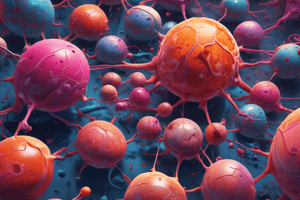Podcast
Questions and Answers
What is the definition of pathology?
What is the definition of pathology?
The study of disease by scientific methods.
What are the two ways cells can die?
What are the two ways cells can die?
Necrosis and apoptosis.
What are the mechanisms by which necrosis occurs? (Select all that apply)
What are the mechanisms by which necrosis occurs? (Select all that apply)
- Increased intracellular calcium level (correct)
- Hypoxia (correct)
- Free radical-induced cell injury (correct)
- Cell membrane damage (correct)
Ischemia is a common cause of acute cell injury?
Ischemia is a common cause of acute cell injury?
What is a possible cause of mercuric chloride poisoning?
What is a possible cause of mercuric chloride poisoning?
What are some examples of infectious agents that can cause cell injury?
What are some examples of infectious agents that can cause cell injury?
Immune reactions are always beneficial to the body and never cause cell injury.
Immune reactions are always beneficial to the body and never cause cell injury.
What is coagulative necrosis most often caused by?
What is coagulative necrosis most often caused by?
What is liquefactive necrosis characterized by?
What is liquefactive necrosis characterized by?
What type of necrosis can be caused by trauma to tissue with high fat content?
What type of necrosis can be caused by trauma to tissue with high fat content?
Caseous necrosis has a characteristic cheese-like appearance.
Caseous necrosis has a characteristic cheese-like appearance.
What are the two types of gangrene?
What are the two types of gangrene?
What is the primary characteristic of necrosis?
What is the primary characteristic of necrosis?
What are the three patterns of nuclear changes in necrosis?
What are the three patterns of nuclear changes in necrosis?
Apoptosis causes the death of clusters of cells.
Apoptosis causes the death of clusters of cells.
What are the characteristic features of apoptosis?
What are the characteristic features of apoptosis?
Apoptosis is followed by inflammation and calcification.
Apoptosis is followed by inflammation and calcification.
What do apoptotic cells in a normal crypt in the colonic epithelium show?
What do apoptotic cells in a normal crypt in the colonic epithelium show?
Flashcards
Pathology
Pathology
The scientific study of disease.
Necrosis
Necrosis
A type of cell death caused by injury, characterized by swelling and membrane rupture.
Apoptosis
Apoptosis
Programmed cell death, often a normal part of development or response to injury.
Hypoxia
Hypoxia
Signup and view all the flashcards
Free radical injury
Free radical injury
Signup and view all the flashcards
Cell membrane damage
Cell membrane damage
Signup and view all the flashcards
Increased intracellular calcium
Increased intracellular calcium
Signup and view all the flashcards
Ischemic injury
Ischemic injury
Signup and view all the flashcards
Toxic injury
Toxic injury
Signup and view all the flashcards
Infectious agent injury
Infectious agent injury
Signup and view all the flashcards
Immune reaction injury
Immune reaction injury
Signup and view all the flashcards
Genetic defects
Genetic defects
Signup and view all the flashcards
Coagulative necrosis
Coagulative necrosis
Signup and view all the flashcards
Liquefactive necrosis
Liquefactive necrosis
Signup and view all the flashcards
Fat necrosis
Fat necrosis
Signup and view all the flashcards
Caseous necrosis
Caseous necrosis
Signup and view all the flashcards
Gangrenous necrosis
Gangrenous necrosis
Signup and view all the flashcards
Loss of membrane integrity
Loss of membrane integrity
Signup and view all the flashcards
Eosinophilia
Eosinophilia
Signup and view all the flashcards
Karyolysis
Karyolysis
Signup and view all the flashcards
Pyknosis
Pyknosis
Signup and view all the flashcards
Karyorrhexis
Karyorrhexis
Signup and view all the flashcards
Study Notes
Definition of Pathology
- Pathology is the scientific study of disease.
- The word pathology comes from Latin words "patho" and "logy".
- "Patho" means disease, and "logy" means study.
Cell Death
- Cells can die in two ways: necrosis and apoptosis.
Necrosis
- Excess fluid enters the cell, causing swelling and rupture of the cell membrane.
- Enzymes for cell digestion come from dying cells or leukocytes.
- Necrosis can occur due to different mechanisms:
- Hypoxia
- Free radical-induced cell injury
- Cell membrane damage
- Increased intracellular calcium level
- Causes of cell injury and necrosis:
- Ischemic and hypoxic injury (reduced blood flow)
- Chemical (toxic) injury (e.g., mercury chloride poisoning)
- Infectious agents (viral, bacterial, fungal)
- Immunological reaction (immune system attacking cells)
- Genetic defects
Types of Necrosis
- Coagulative necrosis: Often results from sudden interruption of blood supply to an organ (e.g., heart).
- Liquefactive necrosis: Tissue digestion and softening, leading to liquefaction, typically seen in suppurative infections (pus formation).
- Fat necrosis: Caused by trauma to tissues with high fat content (e.g., breast).
- Caseous necrosis: Has a cheese-like appearance; typical in tuberculosis.
- Gangrenous necrosis: Often affects lower extremities or bowel due to vascular occlusion; can be wet (with liquefactive necrosis) or dry (only coagulative).
Apoptosis
- Apoptosis is the death of single cells within clusters of other cells.
- Apoptosis involves cell shrinkage and increased acidophilic staining.
- Cell fragments are called apoptotic bodies.
- Apoptosis occurs as a normal physiological process (e.g., development, menstruation).
- Apoptosis can also occur in pathological conditions due to mild injury.
- Apoptosis is not followed by inflammation or calcification.
- Necrosis vs. Apoptosis: Apoptosis and Necrosis differ in their morphological appearance.
Morphology of Necrosis
- Cytoplasmic changes: Increased eosinophilia (pink).
- Nuclear changes: Three patterns: karyolysis (chromatin fading), pyknosis (nuclear shrinkage), karyorrhexis (fragmentation).
- The nucleus may completely disappear within 1-2 days.
Morphology of Apoptotic Cells
- Apoptotic cells generally show fragmented nuclei with condensed chromatin.
- Apoptotic cells have shrunken cell bodies.
Studying That Suits You
Use AI to generate personalized quizzes and flashcards to suit your learning preferences.





